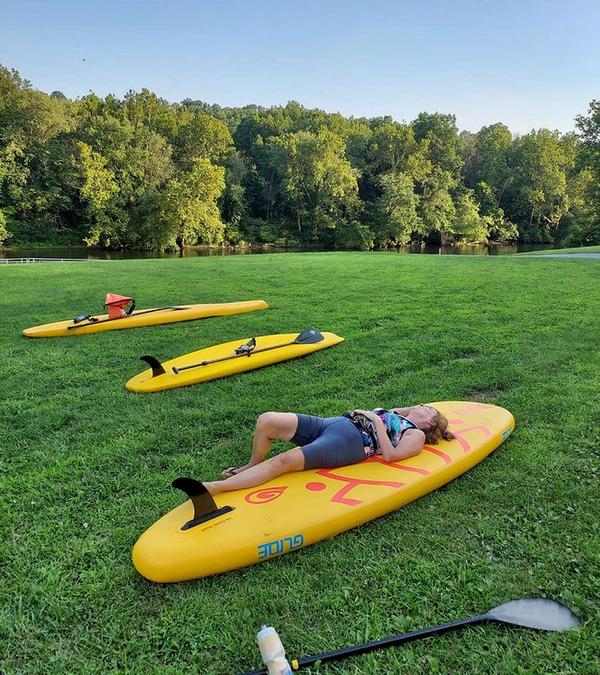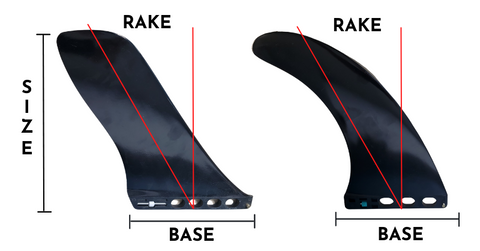
Paddle Board Fins Made Easy: Pick the Right Fin, Feel the Difference
Make your SUP feel better in minutes. Learn fin depth, base, and rake—and when to use dolphin, pivot, keel, river, or touring fins. Simple picks for flatwater, touring, shallow water, surf, and rivers.
Paddle board fins control how your paddle board tracks, turns, and handles. Depth influences clearance and leverage; base and rake strongly shape tracking versus agility.
For most paddlers, a medium dolphin fin delivers balanced performance on flatwater.
For long tours/straight lines, pick an upright race/touring fin with a long base; for shallow water and weed beds, a keel/shallow fin shines.
Rivers call for short, flexible river fins; surf and buoy turns benefit from an upright/pivot template.
Fine-tune with box position (forward = turny; back = tracky). Keep a two-fin quiver, maintain your gear, and use short tests to dial in feel fast.
Table of contents
Your fin is tiny compared to your board—but it has an outsized effect on how your SUP tracks, turns, and feels underfoot. Get the fin right and your board runs straighter, turns when you ask, and stays calm in chop. Get it wrong and you’ll fight yaw, catch weeds, or scrape bottom all day. This guide makes fin choices simple: what the terms mean, how size and shape change performance, and which fin to use for flatwater, touring, yoga/fishing, rivers, surf, and racing.
Quick wins (what most paddlers need)
-
Flatwater cruising and fitness: a medium dolphin fin (about 7–9" depth) for balanced tracking and easy turning.
-
Long tours and straight lines: a taller touring/pivot-style fin with a long base for stronger tracking.
-
Shallow water, fishing, or rocky launches: a keel/shallow fin (3–5") that still tracks but won’t snag bottom.
-
Rivers/whitewater: a short, flexible river fin (2–4") that bounces off rocks and won’t trip you up.
-
Surf and quick pivots: a more upright (pivot) template that releases fast for tight turns.
Fin terms without the headache
It’s a fin (not a skeg or rudder).
-
Fin = fixed or removable blade under your board that helps with directional stability (tracking) and turning.
-
Rudder = steerable device you control with feet/hands (rare on SUPs).
Depth (aka “size”).
-
How tall the fin is below the board. Deeper fins usually track better but turn slower and snag weeds/shallow bottom more easily.
Base (the length along the board).
-
Longer base = more tracking and stability in a straight line.
-
Shorter base = quicker, easier turning.

Rake (sweep).
-
More rake (fin leans back) = sheds weeds, smooths tracking, feels calm—but turns a bit slower.
-
Less rake (more upright) = pivots/turns faster, handy for surf and buoy turns—but can wander more in straight lines.
Materials.
-
Rubber/soft plastic: forgiving for rentals/rivers; safe around rocks.
-
ABS/nylon: durable, budget-friendly all-rounders.
-
Fiberglass/carbon: stiffer, crisper feel, lighter weight for performance.
Mount systems.
-
US box (screw + plate): slide to fine-tune position; huge template variety.
-
Tool-less/snap-in (on many iSUPs): fast swaps; check compatibility/locking tab fit.
-
Tip: A fin saver or tether is cheap insurance during travel and river days.
How fin shape changes your ride
1) Dolphin (raked all-around)
The most common SUP fin for a reason.
-
What it is: Moderately deep, medium base, noticeable rake.
-
Feels like: Balanced; tracks nicely but still turns.
-
Best for: Flatwater, fitness cruising, touring on calm lakes, SUP yoga (stable), light surf.
-
Tweak it:
-
Go shorter (5–7") for shallows and quicker turning.
-
Go taller (8–10") for straighter lines on longer routes.
-
2) Pivot (more upright template)
Great when you want snappy turns and fast buoy spins.
-
What it is: Upright leading edge, often with a long base; less rake.
-
Feels like: Quicker pivot/turns; depending on base length it can still track well, but it’s livelier than a raked dolphin.
-
Best for: Racing buoy turns, surf, technical downwind maneuvering, and paddlers who prefer a more reactive tail.
-
Note: If you want maximum tracking, pick a pivot design with a longer base (many “race/touring” fins are upright but long-based); if you want maximum agility, go upright and keep the base modest.
3) Keel / shallow (raked, low depth)
Your friend in shallow bays, rivers, and rentals.
-
What it is: Short depth, long base, and lots of rake.
-
Feels like: Surprising stability and tracking for a small fin; safe in shallow water; less likely to snag.
-
Best for: Shallow lakes/rivers, fishing, family/rental fleets, iSUPs that stack during storage.
-
Trade-off: Turns slower than its size suggests; not ideal for sharp carving.

Which fin for which day (simple picks by activity)
-
Casual flatwater & fitness: Dolphin 7–9", set slightly aft for tracking.
-
Touring/straight lines: Upright race/touring fin with a long base and 8–10" depth; set aft for max tracking.
-
Shallow/fishing/rocky: Keel/shallow 3–5" with long base and rake; set center.
-
Rivers/whitewater: Soft, short river fin 2–4"; consider multiple mini-fins (thruster-style iSUPs) for bite without depth.
-
Surf/quick pivots: Upright/pivot template around 6–8"; set forward for faster release and tighter turns.
-
Weedy lakes: Choose raked (weed-shedding) templates; avoid upright points that catch strands.
Fin placement in the box (free performance)
-
Slide forward = quicker turning, looser tail (nice for surf, marinas, buoy turns).
-
Slide back = straighter tracking, calmer board (nice for touring, cross-wind).
-
Start at center and move in ½" steps until the board feels “right.”
Size guide (ballpark depths)
-
2–4": river/ultra-shallow/rocky.
-
5–7": maneuverable all-around, kids, very shallow.
-
7–9": all-around dolphin for flatwater/fitness.
-
8–10": touring/race tracking, long base; weed-shedding rake if needed.
(Depth is only part of the story—base and rake often matter more for how the board truly feels.)
Common fin myths (and quick truths)
-
“Bigger always tracks better.”
Bigger depth helps, but base length and rake are huge for tracking; an upright tall fin can still feel squirrelly if the base is short. -
“Keel fins are only for rentals.”
They’re fantastic for shallow paddling and weed-prone waters—even for experienced paddlers who value clearance. -
“One fin does it all.”
You can make one fin work—but a two-fin quiver (dolphin + shallow/river) covers 90% of needs.
Care, travel, and quick fixes
-
Rinse after salt or muddy water; check the edge for nicks (a smooth edge enters water cleanly).
-
Tighten the screw/plate; carry a spare plate/screw (they love disappearing at ramps).
-
For iSUPs: keep PSI up; a stiff board makes any fin feel better.
-
Traveling? Use a fin case or wrap in a towel; tool-less tabs can snap if tossed in a duffel.
Try this 10-minute fin test
-
Paddle 5 minutes with your current fin placed center.
-
Slide it ½" back; paddle the same route for 3 minutes. Notice tracking.
-
Slide it 1" forward from center; paddle 3 minutes. Notice turning.
-
Log what feels better and leave it there for your next similar session.
Small changes = big differences.

Final Thoughts on Paddle Board Fins
You don’t need a giant fin collection to make your SUP feel great. Start with a trustworthy dolphin fin, add a shallow/river backup, and you’ve covered almost everything. When your paddling goals evolve—tour farther, chase buoys, surf more—add a template that matches that day. Remember: slide position first, swap fins second. Most of the magic is in small, reversible tweaks.
FAQs
Which fin should I buy first?
A medium dolphin fin (7–9")—it’s the most versatile for flatwater and fitness.
How do I stop my board from wandering side to side?
Use a fin with a longer base and/or slide your fin back in the box for more tracking. Also check your stroke (vertical shaft, exit at feet).
What fin for shallow lakes and weed beds?
A keel/shallow fin with lots of rake to shed weeds and avoid scraping bottom.
Are upright “pivot” fins only for surf?
They’re great in surf and also useful for buoy turns and maneuvering; pick a long-base version if you still want decent tracking.
Do materials matter?
Yes. Fiberglass/carbon are stiffer and crisper; ABS/nylon are durable; rubber is safest around rocks and rentals.
How tight should the fin screw be?
Snug, not gorilla-tight. Recheck after your first few minutes—vibration can loosen new installs.
My iSUP came with a snap-in fin—should I upgrade?
If it feels fine, keep it. If you want better tracking or agility, look for a tool-less upgrade in the template you want.
How does board stiffness affect fin feel?
A soft iSUP mutes fin benefits. Inflate to recommended PSI; a stiff board makes any fin work better.
Can I use multiple small side fins?
Some iSUPs use 2+1 or thruster-style boxes. Multiple small fins can add bite in shallow or river settings without deep depth.
What’s the fastest way to test differences?
Run the 10-minute fin test above on a familiar route and log your impressions right after.





